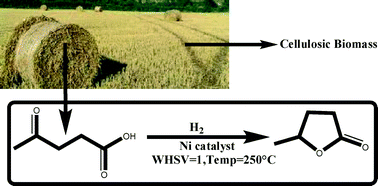Vapour phase hydrocyclisation of levulinic acid to γ-valerolactone over supported Ni catalysts
Abstract
Various Ni catalysts with 30 wt% Ni content were prepared by a conventional wet impregnation method using different supports such as Al2O3, SiO2, ZnO, ZrO2, TiO2 and MgO. The prepared catalysts have been characterised by XRD, N2 physisorption, H2 pulse chemisorption, pyridine adsorbed FTIR, ammonia-TPD, TPR, XPS and TEM techniques. Pyridine adsorbed IR patterns reveal the presence of both Lewis as well as Brønsted acid sites which are responsible for the dehydration of the intermediate 4-hydroxy valeric acid to yield γ-valerolactone. Ammonia-TPD profiles also showed the presence of acidic sites in all catalytic systems, which explains the formation of the targeted product. The better activity shown by the 30 wt% Ni/SiO2 catalyst (signifying maximum productivity, i.e., 0.8506 kgGVL kgcatalyst−1 h−1 at 250 °C) is due to the presence of a greater number of surface Ni species. The present work aims to provide a continuous down flow process for the hydrocyclization of one of the biomass derived platform molecules such as levulinic acid over non-noble metal (nickel) based catalysts. The Ni/SiO2 catalyst is tested for 25 h and found to be stable during the time on stream which reveals its robustness.


 Please wait while we load your content...
Please wait while we load your content...